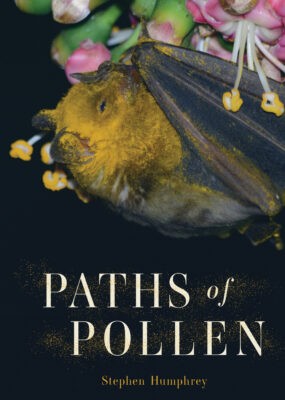Paths of Pollen is about the sex lives of plants. And, as one scientist remarks in the book, “it’s complicated, man.” Author and citizen scientist Stephen Humphrey attempts to untangle the messy, ancient, multispecies relationships at the heart of plant life and the production of most food on the planet. In doing so, he offers a cautionary tale about the perils of anthropogenic climate change.

Paths of Pollen
Stephen Humphrey
McGill-Queen’s University Press
$39.95
paper
272pp
9780228018971
It is pollinators that dominate Paths of Pollen, and there is nothing wrong with that. Humphrey describes interesting and important research being conducted on many of these animals – honeybees and monarch butterflies, hummingbirds and Charles Darwin’s long-tongued moths. Perhaps more importantly, he demonstrates that most pollination is accomplished by less well-known, and often less adorable, creatures that nonetheless deserve our admiration. Hard-working solitary bumblebees that live in small holes in the ground, opportunistic carpenter bees (known lovingly as “trash bees” to their researcher), and the assorted flies that do much of the pollination in the Arctic – all take their rightful places as captivating subjects and tiny environmental superheroes.
Other chapters focus on flowering plants from a variety of perspectives, including their prehistoric beginnings, their hermaphroditic tendencies and sexual trickery, the effects of herbicides, the future of genetic modification, restoration of native prairie grasses, and backyard gardening. An interesting early chapter on wind pollination, and related seasonal allergies in humans, comes closest to making pollen the star of the story.
The first part of the book is a bit scattershot, and it takes several chapters to settle into a clear rhythm and focus. But throughout it is filled with fascinating details about plants, pollinators, and environmental change, as well as discussions of intriguing scientific research on these topics. While Humphrey’s story spans the globe, including Mexican bats and European sunflowers, his Canadian orientation sheds light on examples that might not appear in a book published elsewhere. For instance, we learn about the wild sweat bees of Sable Island, fossilized forests preserved in the cliffs along the Bay of Fundy, artist-made bee condos in Toronto, and urban pollinator gardening in Calgary.
Work by researchers at Canadian universities receives well-deserved attention in the book. Among the highlights that Humphrey shares are scientists studying light and colour perception in bees, another who measures the temperature of “micro-climates” inside heliotropic flowers as an indicator of broader atmospheric conditions, and a collaborative project between university researchers and Inuit community members to monitor culturally important berry species while preserving oral history and language.
Concern about the future of plants drives Humphrey’s curiosity and leads him to draw together a variety of interesting topics that reveal the many interconnected relationships between plants, pollinators, and people. Ongoing changes to fragile networks of biodiversity, including landscapes, climate, weather patterns, and insect populations threaten to unbalance the ecosystems that make life on Earth possible. With Paths of Pollen, Humphrey has extended an accessible invitation to consider these relationships at multiple scales, from the wide view of global environmental activism to the microscopic perspective of a grain of pollen.mRb






0 Comments